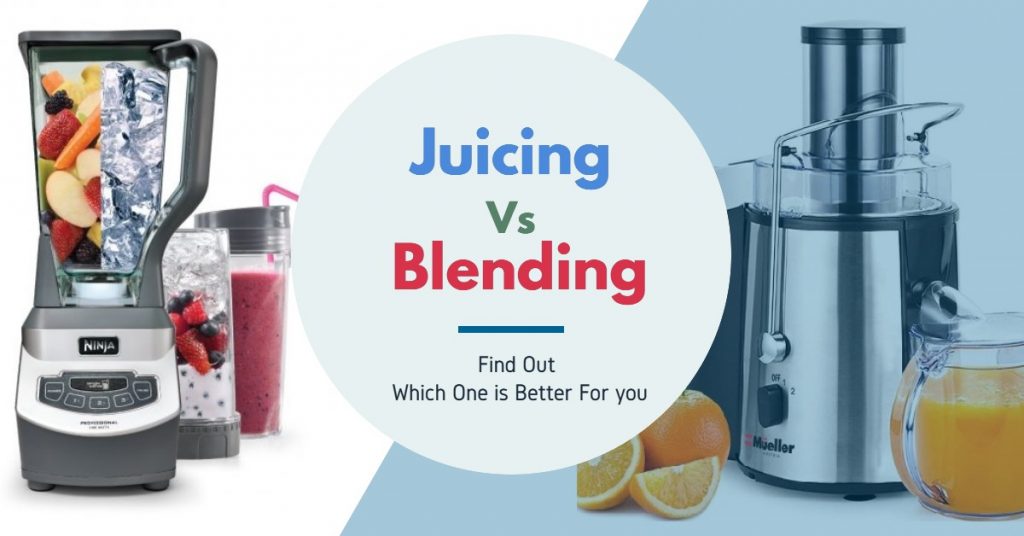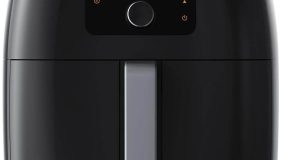
The hottest debate of our century is to know the healthiest method by which we can turn fruits and vegetables into juice to drink?
Although scientists insist that produce is healthiest when eaten whole, most people prefer it in liquid form. So let’s break down juicing and blending before coming to a verdict.
Juicing
Juicing is the process of extracting the juice from the plant, leaving out all the insoluble fiber and anything solid such as seeds or pulp.
This process of extraction leads to drinking the number of fruits and vegetables in one cup that you would blend in a blender for 3 or 4 cups.
This highly concentrated product of juicing is called ‘juice.’
Types of Juicers
Centrifugal Force Juicer:
It is also known as a fast juicer and is the most popular one.
It shreds produce very quickly with a fast-spinning flat cutting blade. Then, the juice is separated from the pulp with the centrifugal force.
Masticating Juicer:
It is also known as the slow juicer. The juice is made with a slow auger (gear) that crushes produce against a mesh to separate the liquid from the solids.
Cold Press juicer:
Cold press juicers are generally known to make better quality juices that retain most of the ingredients’ nutritional value. Check out the best cold press juicer on the market.
Why Do People Juice?
Juicing has become a health trend since the late 90s, and it is still going strong with Instagram influencers. But why? It is mainly for two reasons:
To consume more produce:
Most people don’t have a sufficient and regular intake of fruits and vegetables, thus they miss out on a lot of essential nutrients. Juicing helps compensate for the lack of nutrients as a quick fix.
To juice cleanse:
It’s a diet that consists of consuming juice alone for 3 to 10 days to detoxify the body and lose weight.
It is important to say that no scientific evidence supports the claims of the juice cleanse, but that hasn’t stopped it from dominating social media and health blogs.
Why Not?
Although bloggers and influencers swear by this practice, it has its share of haters for the following reasons:
Incredibly Expensive:
Filling up your entire fridge with produce can only give you a few cups of juice. This is way more than you need to make actual meals.
In addition, a decent juicer can cost you from 200 to 1600 USD.
Not Enough Fiber:
One of the main health benefits of consuming produce lies in fiber.
Fiber helps maintain bowel health by reducing the chance of constipation. Also, it keeps gut bacteria healthy by producing short-chain fatty acids that reduce the risk of chronic health problems like obesity.
Also, it helps you maintain a healthy weight by keeping you fuller for longer; lack of fiber will leave you constantly hungry in a way juice will never fix, which may lead to over-consumption of juice.
Fiber is the unknown soldier of keeping sugar at bay. It slows the absorption of sugar and regulates blood sugar levels, thus avoiding diabetes.
One can’t help but notice the irony of the similarity between the health benefits of fiber and, allegedly, juicing, which limits fiber intake in the first place.
Too Much Sugar:
Due to the lack of fiber and the high concentration of juicing, the sugar intake one cup of apple juice may have is disastrous. In one 240-ml cup of apple juice, you consume 114 calories.
Juicing doubles the benefits of fruits, since you are consuming many, but also doubles the drawbacks such as weight gain and tooth decay.
Blending
Blending is the process of grinding produce together, with water, milk, or yogurt, to get a thick drink. This process does not separate the fiber and the juice; it preserves all the nutrients and fiber in fruits and vegetables blended.
This thick-textured drink is called a ‘smoothie.’ Check out the review of the top 6 blenders for green smoothies.
Why Blend?
Although juicing is trending now, people have been blending their produce since 1922. Some people may still not have a juicer, but every house has a blender for the following reasons:
Economical:
Since there is no extraction of components, the product of blending needs much less produce to make you a drink. You need one apple for one 240-ml cup of apple smoothie.
Easier Digestion for Fiber:
Blending breaks down fiber, but still retains it, making it easier to digest for people who find it hard to digest whole fruits and vegetables.
Satisfactory:
Pulp and fibrous cellulose in a smoothie help you stay fuller for longer, making a smoothie much closer to an actual meal than a juice, especially since you can add healthy ingredients such as nuts and seeds.
This, in turn, helps you lose weight, while still getting all the health benefits that fruits and vegetables have to offer.
Provides Moderate Amounts of Sugar:
Since a smoothie is not a concentrated drink and since fiber slows the absorption of sugar, rest assured that the risk of raising your blood sugar is very low now.
Blends It All:
Blenders allow you to blend almost every kind of produce out there, including those thick vegetables that juicers can’t beat.
Why Not?
Although blending is a common household choice, some people just won’t do it anymore for these reasons:
Texture:
The rough texture and the extra pulpiness of smoothies made a lot of people ditch their blenders.
Digestive Problems:
People with IBS, Crohn’s disease, Ulcerative Colitis, or gastroparesis may find consuming fiber problematic to their condition; thus, they stay away from smoothies and drink juices instead.
Final Verdict
Unless you have serious digestive problems that make fiber almost impossible to digest, blending is the right choice for you. It is inexpensive, fulfilling, and moderate in sugar. To add to that, it helps you digest fiber and drink thick produce.
So, if you already have a blender, just keep blending!





